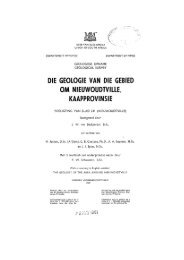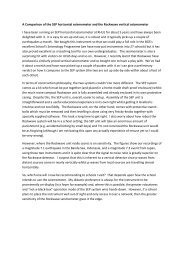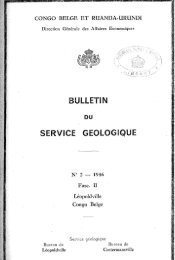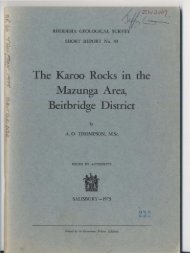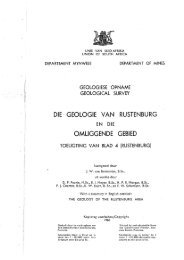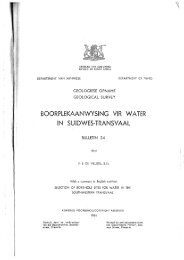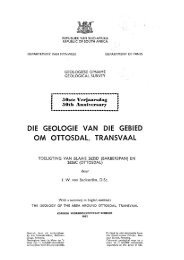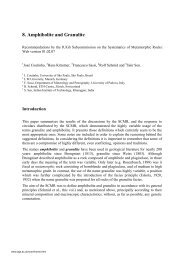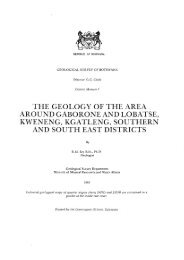Bibliography - British Geological Survey
Bibliography - British Geological Survey
Bibliography - British Geological Survey
You also want an ePaper? Increase the reach of your titles
YUMPU automatically turns print PDFs into web optimized ePapers that Google loves.
Anon. (H. R. H.) 1913c. The Sussex skull. Hastings and St. Leonards Observer, 15 Feb. (A witty poem)<br />
Anon. 1913c. Geologists at Piltdown. Sussex Daily News, 22 April.<br />
Anon. 1913d. [Geologists’ Association excursion to the Piltdown site, Saturday 12 July]. Sussex Daily<br />
News, 14 July. (A photograph of the GA visit to the Barkham Manor pit appears in Weiner 1955, plate 8)<br />
Anon. 1913e. [Report of a meeting of the Anatomical Section of the International Congress of Medicine at<br />
the Royal College of Surgeons on 11 August 1913]. The Times, 12 Aug [not seen]. (Smith Woodward, Elliot<br />
Smith, Lankester, Pycraft, Underwood and Keith were all present at the meeting. It would appear that Keith<br />
was the author of this report (Keith, 1950, 326). Spencer 1990b, 77, states that the now famous painting by<br />
John Cooke, ‘A discussion on the Piltdown skull’, purports to represent a discussion that took place at the<br />
Royal College on the afternoon of 11 Aug. See Cooke 1915)<br />
Anon. 1913f. The antiquity and evolution of man. Nature, 92 (9 Oct), 160–162. (A well informed review<br />
of four recently published books authored by H. von Buttel-Reepen, G. F. Wright, V. Giuffrida-Ruggeri, and<br />
E. Fischer, the first three of which include remarks on Piltdown. The opinion expressed by this anonymous<br />
reviewer with respect to the brain capacity of the Piltdown skull betrays the hand of Arthur Keith.)<br />
Anon. 1913g. The controversy over the discovery of “Dawn Man.” Current Opinion, 55 (Dec), 421–422.<br />
(Recites differing views on the reconstruction of the Piltdown skull as expressed on the one hand by Smith,<br />
Woodward and Pycraft, and on the other by Keith; the two reconstructions are illustrated in dorsal view)<br />
Anon. 1914a. [Exhibition and discussion] of implements and reputed implements of Palæolithic and earlier<br />
age, and of flints showing various types of fracture. Quarterly Journal of the <strong>Geological</strong> Society of London,<br />
70 (1), ii–xii. (This meeting, which took place 19 Nov 1913, was essentially a discussion about the eolithic<br />
controversy. Exhibitors and contributors to the discussion were J. R. Moir, F. N. Haward, S. H. Warren, A.<br />
S. Kennard, A. W. Jamieson, Prof. W. J. Sollas, Rev. H. H. Winwood, H. N. Ridley, O. A. Shrubsole, W.<br />
Dale, N. F. Robarts, G. W. Lamplugh, W. H. Cook, Reginald A. Smith, Walter Johnson, Prof. W. Boyd<br />
Dawkins and P. G. H. Boswell.)<br />
Anon. 1914b. Eskimos’ extra vertebra / members of one arctic tribe show abnormal development. New York<br />
Times, 2 Jan, 1. (‘London, Jan. 1.–Charles Dawson, who found the famous Piltdown skull, has made another<br />
discovery of considerable interest to anthropologists. He has discovered that the members of a certain Eskimo<br />
tribe have literally more backbone than the rest of humanity; that is to say, they have one extra vertebra to<br />
which small ribs are attached. Mr. Dawson has lately been making an examination of various skeleton remains<br />
brought from the arctic regions and has found that both men and women of the Eskimo tribe in question have<br />
this abnormal development.’ The author of this ‘Special Cable to The New York Times’, here quoted in full,<br />
is not identified. See Dawson 1912)<br />
Anon. 1914c. [Note on progress of Piltdown excavations.] Nature, 94 (3 Sep), 5. (‘While continuing their<br />
excavations in the Piltdown gravel last week, Mr. Charles Dawson and Dr. A. Smith Woodward met with a<br />
second portion of a molar tooth of Mastodon larger and more characteristic than the fragment originally<br />
described. The new specimen agrees well with the teeth of Mastodon arvernensis found in the Red Crag of<br />
Suffolk, but is merely a waterworn hindmost ridge, and is evidently a derived fossil of earlier date than the<br />
deposition of the Piltdown gravel itself.’ Full text)<br />
Anon. 1914c. Dawn Man of Piltdown. Scientific American Supplement, 78 (7 Nov), 296–299.<br />
Anon. ( M.S.R.-G.) 1935. Modern South Saxons: No. 74–Sir Arthur Smith Woodward, LL.D., F.R.S.,<br />
F.G.S., F.Z.S., F.R.G.S. Sussex County Magazine, 9 (2) Feb, 74. (Woodward retired as Keeper in the<br />
<strong>Geological</strong> Department of the Natural History Museum in 1924 and was knighted in the same year, ‘...and<br />
he came to live in Sussex to be near Piltdown. He still explores the remarkable gravel deposits in which the<br />
discovery he was the first to record, was made.’)<br />
Anon. 1938. The Piltdown Man discovery: unveiling of a monolith memorial. Nature, 142 (30 July), 196–<br />
197. (Includes substance of a speech by Sir Arthur Keith delivered at the unveiling of a memorial stone in<br />
the grounds of Barkham Manor, Piltdown, on 23 July, marking the spot where the Piltdown skull was found)<br />
Anon. 1953a. Piltdown Man forgery / jaw and tooth of modern ape / “elaborate hoax”. The Times, 21 Nov, 6.<br />
(The Times newspaper was the first to break the startling news concerning the findings of Weiner, Oakley &<br />
Le Gros Clark on the fraudulent nature of the Piltdown jaw and canine. Reports subsequently featured in the<br />
Evening Standard, 21 Nov; The Star, ‘The biggest scientific hoax of the century’, 21 Nov; The People,



